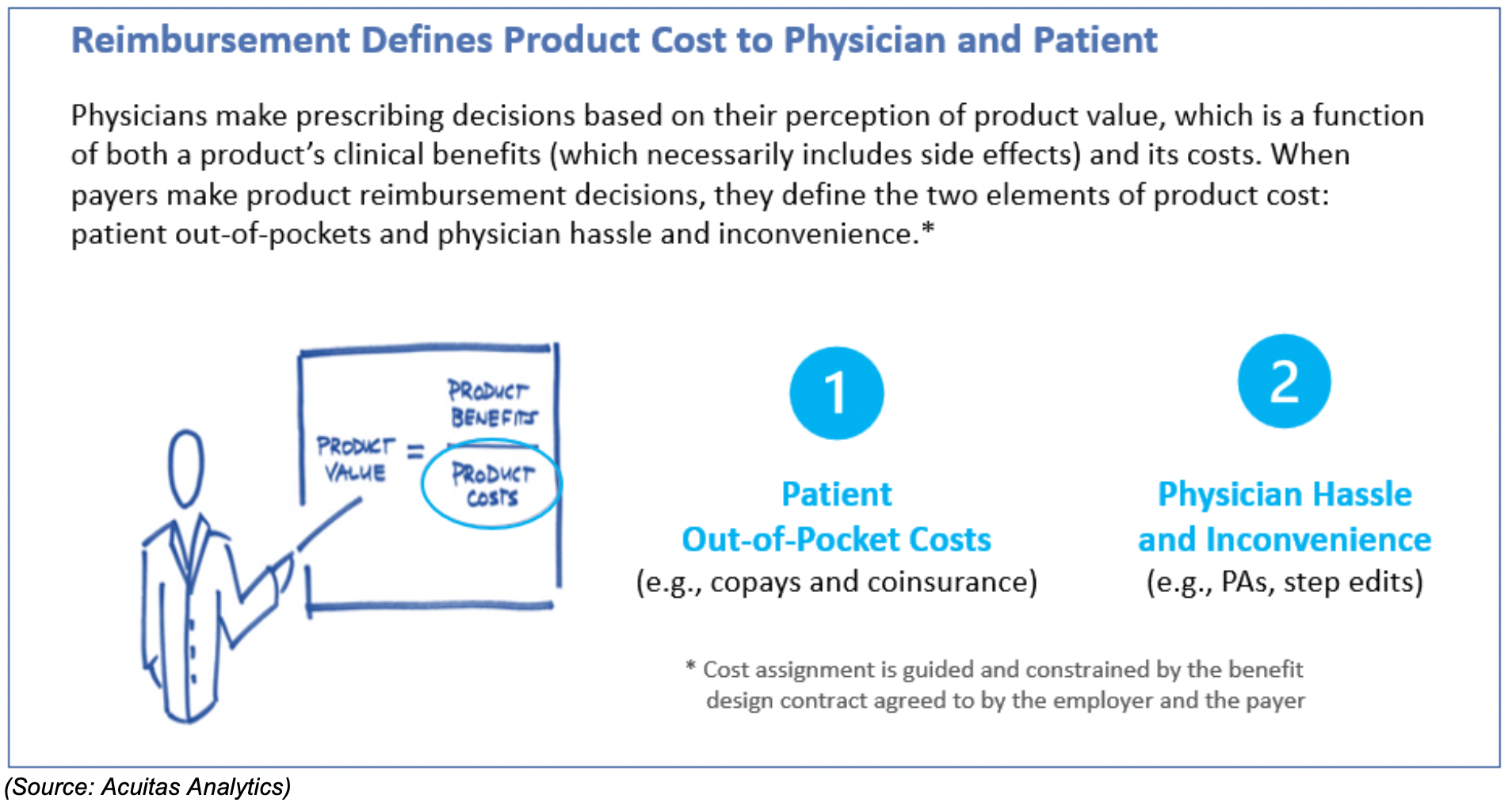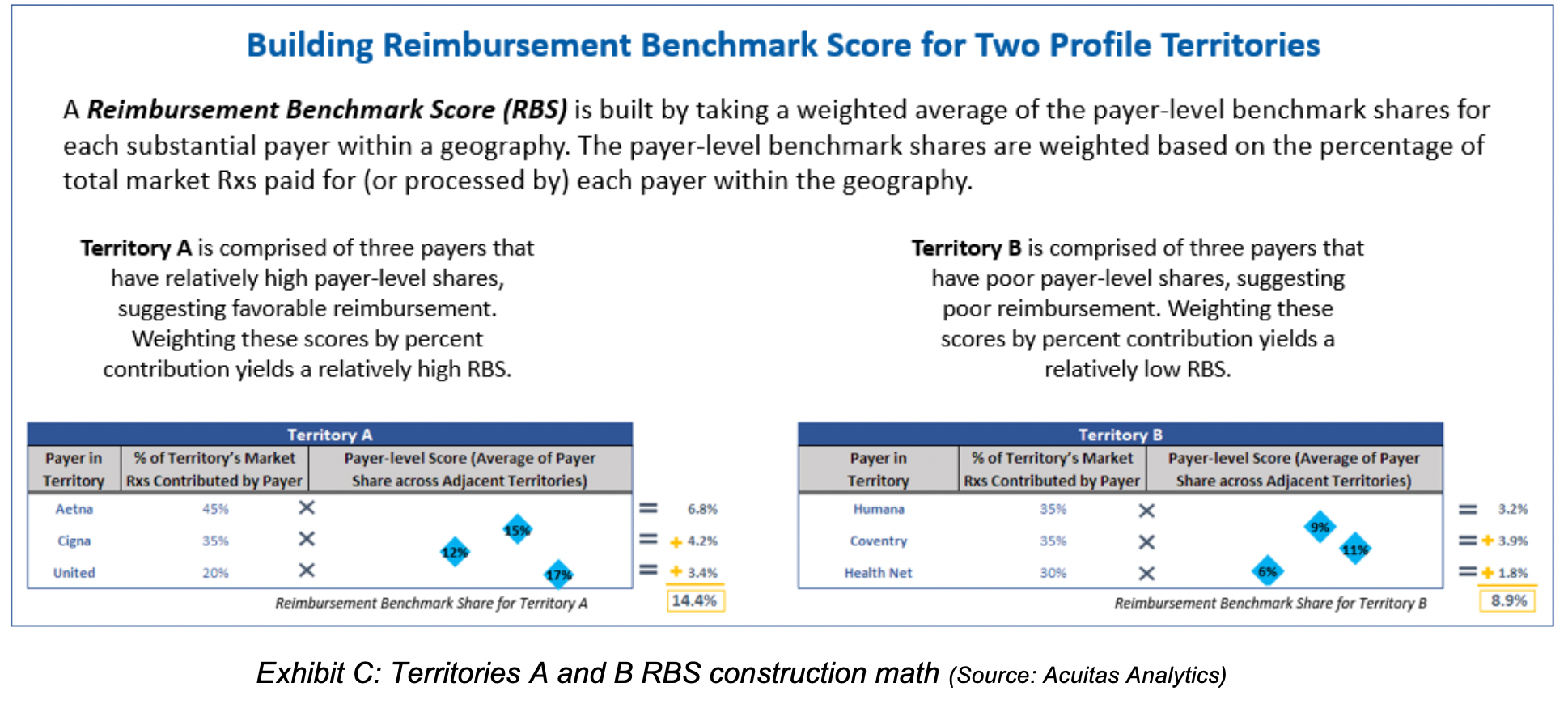Reimbursement Benchmark Share: An Objective Measure of the Impact of Product Reimbursement on Sales Performance
Knowing that product reimbursement affects performance and varies by geography, this article proposes the use of Reimbursement Benchmark Share (RBS) to quantify the influence of reimbursement on a product’s performance.
For most brands, there are two immutable facts related to reimbursement:
Product reimbursement affects performance: All else equal, the better the reimbursement for the product, the better the product will perform.
Reimbursement varies across sales geographies: Some sales geographies will be populated by payers reimbursing the product more favorably than other geographies1.
Together, these two facts mean that certain geographies will perform better than others because of differing reimbursement landscapes. Some sales representatives, reaping the rewards of a reimbursement “tail wind,” will receive accolades. Other representatives, fighting a reimbursement “head wind,” may be labeled as underperforming.
Brand marketers have often sought to reconcile, or to level set, performance to reflect reimbursement across geographies. Among its many benefits, squaring reimbursement ensures representatives are rewarded in accordance with their incremental contribution to performance.
This article proposes the use of a mathematical construct called Reimbursement Benchmark Share (“RBS”) to quantify the influence of reimbursement on a product’s performance.
The following case study weaves through this article to explain how RBS is calculated and applied.
Case study – Territory A vs. B: quantifying the impact of reimbursement
Consider two territories, A and B, below. LowPress (a hypothetical antihypertensive product) has a higher annual market share in territory A than in B.

Knowing that reimbursement is variable across territories obliges the question:
While many factors may affect product performance, reimbursement has the greatest influence on product demand because reimbursement literally defines the “cost” component of product value (see below).

Quantifying payer influence on geography performance can yield strategic and tactical benefits:
- Strategically, quantifying payer influence on territory performance can inform a brand’s marketing, payer contracting, and resource allocation decisions.
- Tactically, quantifying influence can help ensure that compensation of sales representatives accurately reflects their incremental contribution to brand performance.
Exploring whether territory A’s performance is due to more favorable coverage requires an objective score of the reimbursement environment within a geography. The Reimbursement Benchmark Share provides a method to score reimbursement.
Scoring reimbursement via the Reimbursement Benchmark Share
Reimbursement Benchmark Share (RBS) is the performance level2 that a sales geography should achieve given its reimbursement environment. By using RBS, brand teams can:
- score or grade the reimbursement environment for any sales geography (or even physician),
- compare the quality of the reimbursement environment across all sales geographies,
- quantify whether a geography is sufficiently capitalizing on its reimbursement environment, and
- isolate opportunities to further drive sales.
RBS is built by weighting a product’s performance measures (like product market share) for each payer within a territory. The next section reviews how the payer-level scores are developed.
The building block of RBS – the payer-level benchmark share
In the earlier profile, territory A is in district 1. In district 1, there are 5 territories in which Aetna pays for a significant volume of class prescriptions. In these territories, the market share for LowPress through Aetna varies from 12% to 18%. The average market share for Aetna in these territories is 15%.3
The Aetna average share of 15% across these five territories is the building block for a composite territory-level RBS. This score (or share) is applied to the Aetna contribution to each territory to estimate a total territory RBS. Exhibit B graphically illustrates the process of developing a payer-level benchmark share.

The payer-level share derived in this manner is an unassailable building block for a territory-level RBS. This building block is grounded in proof that peer territories have achieved this benchmark share for the same payer (and likely the same product reimbursement4).
The next section demonstrates how this Aetna reimbursement score of 15% is combined with analogous scores for other payers to build a composite territory-level RBS.
Using payer scores to build an aggregate territory-level RBS
Two data points for each substantial payer within a territory must be gathered to build a territory-level RBS. These elements are:
- Payer-level Benchmark Share: This data point is the average market share (or other performance measure) for a payer across adjacent, peer territories. The share developed for Aetna on the prior page is an example of this payer-level benchmark share.
- Contribution to Territory: This data point is the percentage of the territory’s market basket5 prescriptions paid for or processed by the payer. In the example below, Aetna pays for (or processes) 45% of the Rxs within territory A.
Exhibit C shows how these two data points are used for the three payers in territory A (Aetna, Cigna, and United) and three different payers in territory B (Humana, Coventry and Health Net) to calculate a territory-level RBS.6

The RBS for territory A is 14.4% and for territory B is 8.9%. This is the share that territory A and B should achieve given their payer mixes and reimbursement environments. It can be confidently reasoned that territories should achieve this share because peer territories that have the same payers have achieved this average level of performance.
Standing alone, the RBS for a geography is meaningless. As seen in the next section, RBS becomes meaningful when it is compared with 1) the RBS for other territories, and 2) the actual share achieved within the geography.
Applying Reimbursement Benchmark Share: comparing the two territories
Recall earlier that territory A, with a LowPress market share of 11.7%, had a higher LowPress market share than territory B, with a market share of 10.0%. Without consideration of reimbursement environments, the achieved share suggests that the representative in territory A is generating better performance than the representative in territory B.
This is how the two territories compare with their respective RBS scores:

Comparing RBS across territories:Territory A has an RBS of 14.4% and territory B an RBS of 8.9%. The difference between these two measures strongly suggests that territory A has a much more favorable reimbursement environment than B. Territory A should therefore be expected to perform better than B.
Comparing RBS versus actual share: In territory A, the actual share (11.7%) underperforms the RBS of 14.4%. And in territory B, the actual share (10.0%) overperforms the RBS of 8.9%. Although it has a lower actual share, territory B seems to be succeeding given a relatively poor reimbursement environment.
By applying RBS, performance is placed in the context of reimbursement within geographies and it becomes clearer which representative is better capitalizing on reimbursement.
Adding payer-level detail
For an entire territory, comparing actual performance against the Reimbursement Benchmark Share informs a foundational inquiry:
Comparing the share of each payer in the territory against its respective payer score can further confirm the overall conclusion that the representative in territory B is more effectively capitalizing on reimbursement and can also be used to isolate payer-level opportunities to improve performance.
The detailed comparison of the two territories at the payer level is shown below:

Reporting example incorporating RBS
To this point, this article has used abridged examples to explain Reimbursement Benchmark Share and its application. A more realistic reporting example below shows how territory-level RBS and payer-level benchmark shares can be included in a comprehensive geography-level performance report.
Such a report displays performance relative to RBS and payer-level benchmarks. It also helps to prioritize improvement opportunities and to refine the path to improvement.

Reimbursement leader’s share – an evolution of RBS
One shortcoming of RBS is that it applies an “average” share within the geography. Whereas an average share is useful to compare reimbursement environments, it is not aspirational. The goal is not to emulate average geographies – but instead, to emulate (or surpass) leading geographies.
Reimbursement leaders’ shares can be developed by substituting achieved share of leading geographies for the average share used in RBS.
Conclusion
Reimbursement impacts performance and is variable across geographies. Application of Reimbursement Benchmark Share can help to isolate the impact of reimbursement on a sales representative’s performance within a geography.
Initially, incorporation of RBS into reporting can assist in gaining support for the concept and should precede any application of RBS in incentive / compensation calculations.
Acuitas Analytics provides data analytics and reporting systems to assist pharmaceutical and biotech manufacturers in improving the cost-effectiveness of sales and marketing efforts.
www.AcuitasAnalytics.com
Authors
Bill Barr, Zack Blaker, Acuitas Analytics
References
- This article uses the term “geography” as an inclusive description to capture all levels of sales-defined geographies, whether they be regions, districts, territories, or some other construct.
- E.g., market share or other performance measure
- To avoid the disproportionate influence of large Aetna territories that may be performing better or worse than others, the average should be calculated as expressed here. Here the market shares for all territories within the geography are totaled and then divided by the number of territories.
- It is possible that variability in performance is due to different benefit designs purchased by Aetna customers within a specific geography. This possibility can be confirmed or disproven via direct interaction with the payer, or through analysis of other data points.
- Market Rxs are the total prescriptions for the market basket in which the product is included. This contribution furthermore serves as the denominator for the market share calculation.
- To simplify this example, this article assumes that the territory only has three payers. Whereas most territories will have many more payers than three, the same process applies regardless of the number of payers.
Trump: 'Major Tariff' on Pharmaceuticals Coming Soon
Published: April 9th 2025 | Updated: April 9th 2025“We’re going to tariff our pharmaceuticals, and once we do that, they are going to come rushing back into our country," President Donald J. Trump said during a Tuesday night dinner in Washington.
Trump: 'Major Tariff' on Pharmaceuticals Coming Soon
Published: April 9th 2025 | Updated: April 9th 2025“We’re going to tariff our pharmaceuticals, and once we do that, they are going to come rushing back into our country," President Donald J. Trump said during a Tuesday night dinner in Washington.
2 Commerce Drive
Cranbury, NJ 08512
All rights reserved.